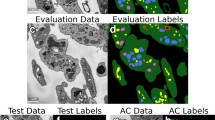Abstract
This research used DeepLab v3 + -based semantic segmentation to automatically evaluate the platelet activation process and count the number of platelets from scanning electron microscopy (SEM) images. Current activated platelet recognition and counting methods include (a) using optical microscopy or SEM images to identify and manually count platelets at different stages, or (b) using flow cytometry to automatically recognize and count platelets. However, the former is time- and labor-consuming, while the latter cannot be employed due to the complicated morphology of platelet transformation during activation. Additionally, because of how complicated the transformation of platelets is, current blood-cell image analysis methods, such as logistic regression or convolution neural networks, cannot precisely recognize transformed platelets. Therefore, this study used DeepLab v3 + , a powerful learning model for semantic segmentation of image analysis, to automatically recognize and count platelets at different activation stages from SEM images. Deformable convolution, a pretrained model, and deep supervision were added to obtain additional platelet transformation features and higher accuracy. The number of activated platelets was predicted by dividing the segmentation predicted platelet area by the average platelet area. The results showed that the model counted the activated platelets at different stages from the SEM images, achieving an error rate within 20%. The error rate was approximately 10% for stages 2 and 4. The proposed approach can thus save labor and time for evaluating platelet activation and facilitate related research.
Graphical abstract








Similar content being viewed by others
References
Modic M, Junkar I, Stana-Kleinschek K, Kostanjšek R, Mozetič M, Polymers PJPPa (2014) Morphology transformations of platelets on plasma activated surfaces. Plasma Processes Polym 11(6):596–605. https://doi.org/10.1002/ppap.201400001
Yun S-H, Sim E-H, Goh R-Y, Park J-I, Han J-Y. 2016 Platelet activation: the mechanisms and potential biomarkers. BioMed research international 2016. https://doi.org/10.1155/2016/9060143.
Cheng K-Y, Lin Z-H, Cheng Y-P, Chiu H-Y, Yeh N-L, Wu T-K, Wu J-S (2018) Wound healing in streptozotocin-induced diabetic rats using atmospheric-pressure argon plasma jet. Sci Rep 8(1):1–15. https://doi.org/10.1038/s41598-018-30597-1
Miao H, Xiao C (2018) Simultaneous segmentation of leukocyte and erythrocyte in microscopic images using a marker-controlled watershed algorithm. Comput Math Methods Med 2018:1–9. https://doi.org/10.1155/2018/7235795
Roy K, Dey R, Bhattacharjee D, Nasipuri M, Ghosh P. 2016 An automated system for platelet segmentation using histogram-based thresholding. 2016 2nd International Conference on Advances in Computing, Communication, & Automation (ICACCA)(Fall) 1–7. https://doi.org/10.1109/ICACCAF.2016.7749000.
Jiang Y, Lei C, Yasumoto A, Kobayashi H, Aisaka Y, Ito T, Guo B, Nitta N, Kutsuna N, Ozeki Y (2017) Label-free detection of aggregated platelets in blood by machine-learning-aided optofluidic time-stretch microscopy. Lab Chip 17(14):2426–2434. https://doi.org/10.1039/C7LC00396J
Pokrovskaya ID, Yadav S, Rao A, McBride E, Kamykowski JA, Zhang G, Storrie B (2019) 3D ultrastructural analysis of α-granule, dense granule, mitochondria, and canalicular system arrangement in resting human platelets. Res Practice Thromb Haemost 4(1):72–85. https://doi.org/10.1002/rth2.12260
Kihm A, Kaestner L, Wagner C, Quint S (2018) Classification of red blood cell shapes in flow using outlier tolerant machine learning. PLoS Comput Biol 14(6):e1006278. https://doi.org/10.1371/journal.pcbi.1006278
Xu M, Papageorgiou DP, Abidi SZ, Dao M, Zhao H, Karniadakis GE (2017) A deep convolutional neural network for classification of red blood cells in sickle cell anemia. PLoS Comput Biol 13(10):e1005746. https://doi.org/10.1371/journal.pcbi.1005746
Zhang M, Li X, Xu M, Li Q. 2018 RBC semantic segmentation for sickle cell disease based on deformable U-Net. International Conference on Medical Image Computing and Computer-Assisted Intervention 695–702. https://doi.org/10.1007/978-3-030-00937-3_79.
Shahzad M, Umar A.I, Khan M.A, Shirazi S.H, Khan Z, Yousaf W. 2020 Robust method for semantic segmentation of whole-slide blood cell microscopoc images. Computational and mathematical method in medicine 1–13. https://doi.org/10.1155/2020/4015323.
Guay M-D, Emam Z-A, Anderson A-B, Aronova M-A, Pokrovskaya I-D, Storrie B, Leapman R-D (2021) Dense cellular segmentation for EM using 2D–3D neutral network ensemble. Sci Rep 11(1):1–11. https://doi.org/10.1038/s41598-021-81590-0
L-C Chen Y Zhu G Papandreou F Schroff H Adam 2018 Encoder-decoder with atrous separable convolution for semantic image segmentation Proc Eur Confer Comput Vis (ECCV) 801–818. https://doi.org/10.1007/978-3-030-01234-2_49
Lee C-Y, Xie S, Gallagher P, Zhang Z, Tu Z. 2015 Deeply-supervised nets. Artificial intelligence and statistics 562–570.
Dai J, Qi H, Xiong Y, Li Y, Zhang G, Hu H, Wei Y. 2017 Deformable convolutional networks. Proceedings of the IEEE international conference on computer vision 764–773. https://doi.org/10.1109/ICCV.2017.89.
He K, Zhang X, Ren S, Sun J. 2016 Deep residual learning for image recognition. Proceedings of the IEEE conference on computer vision and pattern recognition 770–778. https://doi.org/10.1109/CVPR.2016.90.
Deng J, Dong W, Socher R, Li L-J, Li K, Fei-Fei L (2009) Imagenet: a large-scale hierarchical image database. IEEE Confer Comput Vis Pattern Recognit 2009:248–255. https://doi.org/10.1109/CVPR.2009.5206848
Simonyan KZisserman A. Very deep convolutional networks for large-scale image recognition. arXiv preprint arXiv:1409.1556 2014. arXiv:1409.1556
Poursafa P, Kelishadi R (2010) Air pollution, platelet activation and atherosclerosis. Inflamm Allergy-Drug Targets (Formerly Current Drug Targets-Inflammation & Allergy) 9(5):387–392. https://doi.org/10.2174/187152810793937982
Acknowledgements
The authors would like to thank Prof. Chong-Sin Wu for providing the experiment equipment.
Author information
Authors and Affiliations
Corresponding author
Ethics declarations
Conflict of interest
The authors declare no competing interests.
Additional information
Publisher's note
Springer Nature remains neutral with regard to jurisdictional claims in published maps and institutional affiliations.
Rights and permissions
About this article
Cite this article
Kuo, TC., Cheng, TW., Lin, CK. et al. Using DeepLab v3 + -based semantic segmentation to evaluate platelet activation. Med Biol Eng Comput 60, 1775–1785 (2022). https://doi.org/10.1007/s11517-022-02575-3
Received:
Accepted:
Published:
Issue Date:
DOI: https://doi.org/10.1007/s11517-022-02575-3




